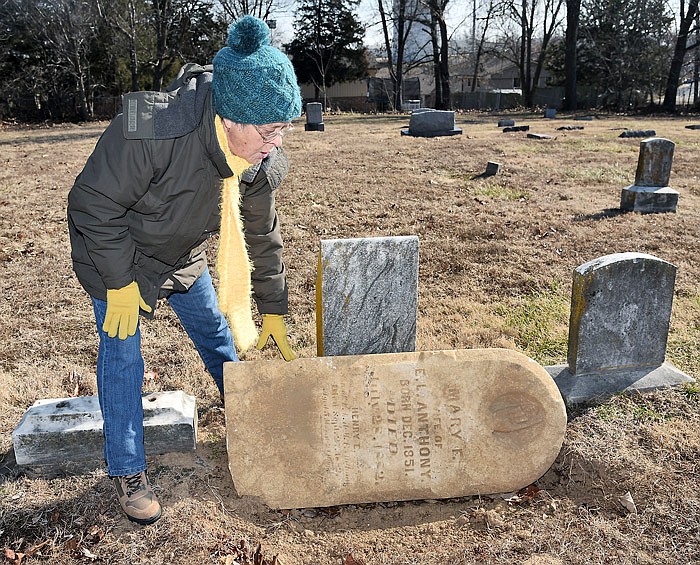Face down in the sod, the grave marker of a mother and her infant was unearthed recently on a tour by Jefferson City's Cemetery Resources Board through Longview Cemetery, 204 Scott Station Road.
Mary Anthony's husband, Elmore, who was a U.S. Colored Troops Civil War veteran and principal at Washington School, is buried at the Jefferson City National Cemetery. Her own death date preceded the opening of Longview Cemetery in 1922, and her death certificate says she was buried at Hedge Grove Cemetery.
Many of the stones surrounding hers also have death dates prior to Longview, leading board Chairman Nancy Thompson to seek out their story.
Drawing upon her review of Cole County death records after 1910 at the Missouri State Archive, Thompson noticed several black residents were buried at Hedge Grove Cemetery prior to 1930.
Hedge Grove Cemetery was a privately owned black cemetery used from the 1880s to the 1920s, located at the southwest corner of High and Benton streets - including 1212 E. High St., where a vacant church sits today - before the burials were relocated to Longview.
"I was under the impression Old City Cemetery was the only place for black burials," she admitted. "That was a false assumption, so I had to go back and look again."
Eventually, Thompson was able to connect many death certificates naming Hedge Grove as the burial site with more than a dozen known markers at Longview.
All of the names she has identified have been uploaded to Findagrave.com under Hedge Grove and Longview cemeteries.
The next question: how did they get there?
Hedge Grove was purchased by the black community in early 1878 as a "new burial ground" because, as representatives told the City Council: the "parents, children, brothers and sisters, whose last resting place is nothing more than the commons - over which the stock roam."
The State Journal reported in November 1877, "The condition of the colored burying ground is such as to demand the immediate attention of the the city authorities." A large portion was too rocky to be used for burials, and the remainder was so full "they are actually burying one above the other."
By 1931, Hedge Grove Cemetery was sold at public auction to contractor Louis Brunner, who had built Benton Street.
"The court directed the cemetery be sold to satisfy the judgment and Jefferson City will soon have the unusual spectacle of a cemetery being sold to the highest bidder," the Jefferson City Post Tribune reported Oct. 19, 1931.
Brunner secured the cemetery as the result of unpaid tax bills levied against the Hedge Grove Cemetery Association, the Daily Capital News reported Oct. 3, 1933. At that time, Brunner was asking the city to buy the cemetery from him after a sale at the courthouse drew no bidders.
By 1934, the county circuit court attempted to sell the property again, finding G.W. Dupree the sole surviving trustee of Hedge Grove.
Two years later, the black community was still trying to remove those interred at Hedge Grove. The Daily Capital News reported Sept. 15, 1936, that the city voted to finance the transfer of the remaining bodies "to a tract in city cemetery."
Community leader Duke Diggs told the Council in 1936 the black community had collected $200 to relocate about half of the burials.
Thompson said the "city cemetery" by that time would have been Longview, which opened about 1929.
A section of Longview Cemetery, near the Hedge Grove burial group, is an unmarked area of 12 plots identified by the late hobbyist Marion Miller, who surveyed the cemetery in 1997, as the Hedge Grove infants.
For many, the rediscovery of Hedge Grove Cemetery's existence was "a revelation; so many had never heard of it," she said after talking to historians and members of the black community.
"It was a total blank spot."
Thompson has sought out descendants of those identified burials and has reached out to existing organizations, such as Second Baptist Church and the Masons, in an attempt to identify the rest of the unmarked burials in the Hedge Grove area.
She hopes local families who have information about ancestors buried at Hedge Grove will share that information with the city cemetery board.
"Even a family Bible could help," Thompson said. "I feel like I have turned over every stone I can think of; I never miss an opportunity to talk to someone.
"We want to make a permanent record. I don't think people should vanish just because they're dead."
In addition to helping with identification, locating the reinterred sites would help the city to secure an exact number of unused plots still available. Longview is an active cemetery.
Since the death certificates, which account for identification of about half of the 50-plus known burials, did not begin until 1910, Thompson said there are 30 years of burials at Hedge Grove likely unrecorded.
"There has to be a whole heck of a lot more people buried there," Thompson said. "It will require knowing family genealogy to shed light on it."

